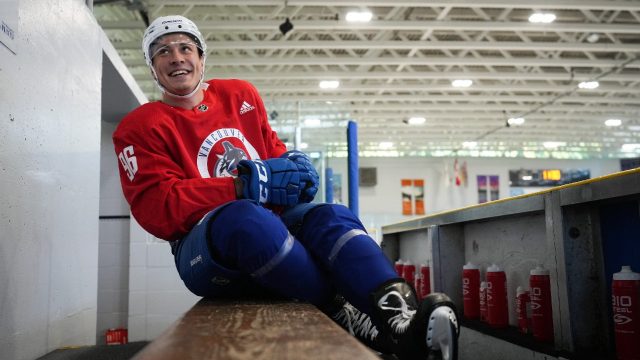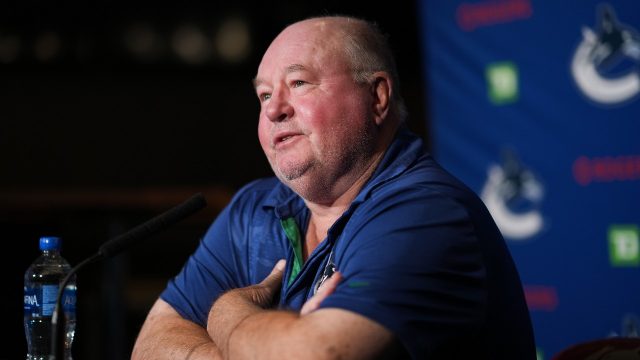WHISTLER, B.C. — Sixteen months ago, at the end of Nils Hoglander’s rookie season amid the pandemic, the discussion around him was about his potential to become another of the Vancouver Canucks’ young, core players — someone essential to their future.
In training camp here ahead of the Swede’s third season, the discussion is whether he’ll even make the roster next month.
That’s how disappointing the second National Hockey League season was for Hoglander.
The dynamo forward plummeted from the Canucks’ top six and saw his minutes decline under new coach Bruce Boudreau, who even made Hoglander a healthy scratch in February before a groin injury a month later put an exclamation mark on the winger’s sophomore slump.
He had managed to exasperate two head coaches in one season, as both Boudreau and his predecessor, Travis Green, expressed concern about Hoglander’s play and awareness without the puck.
When he reported to Whistler, Hoglander found himself on Boudreau’s “fifth line,” assigned to skate with Linus Karlsson and Nils Aman, Swedish prospects who almost certainly will start the season in the American Hockey League.
Through two days of camp, Hoglander has done everything he can to prove he doesn’t belong there.
“I was going to say, let me talk about Hogs because I think he’s the best player on the ice right now,” Boudreau said Friday after the second day of camp. “He looks so much faster than he did last year. Determination. He’s definitely, you know, he’s definitely ready. Last year was a little bit of a setback for him and he doesn’t want it to happen again.”
Hoglander’s speed stands out, and on Friday he seemed to bury every good scoring chance he had during drills. But what was exceptional was his competitiveness, how physical and determined he was in his puck battles and one-and-one drills.
At five-foot-nine and 185 pounds, Hoglander is getting under the shoulders of taller players, using his strength and low centre of gravity against defenders.
“It’s definitely a response,” Boudreau said. “He saw who got signed and everything else. He’s counting (NHL jobs) and he’s going, ‘Well, I better get my stuff together.’ And he is. He’s doing a great job.”
The Canucks signed Russian free agents Ilya Mikheyev and Andrei Kuzmenko over the summer, and those guys are playing with Elias Pettersson far above Hoglander. But the team also rebuilt its fourth line, adding experience and size that will make it difficult for Hoglander to secure a spot there.
To play, he probably has to be in the Canucks’ top nine, possibly ahead of Kuzmenko if the newcomer struggles to adapt to the NHL and smaller ice or is held back by conditioning.
“You always want to be in the top lines, but sometimes you aren’t,” Hoglander said when asked about starting on the fifth line. “Then you just have to work your way up. It’s a challenge to come back again, and I take that challenge and I’m ready for it. I’ve been working all summer for this camp and this season, so I should be ready.
“I mean, this time of year, you’re always excited to come in and take a spot on the team. And I feel more excited now because I had it a little bit tough last year and I had the injury and I’m just ready to come back and show I can play.”
Hoglander’s sophomore season was far from a disaster statistically. He didn’t shoot as well or score as often, managing only 10 goals and 18 assists in 60 games after amassing 13 goals and 27 points in 56 games as a rookie. But he still drove possession with a shot share of 53.3 per cent.
His coaches, however, publicly noted the flaws and lack of structure in Hoglander’s overall game, and his average ice time fell to 13:05 from his rookie TOI of 15:27 when he was a sparkling source of hope in an otherwise dark and desultory Canucks season. Hoglander’s name periodically surfaced in trade rumours, and continues to do so.
“It’s not like the whole defensive zone, it’s small things, like coming back and stopping (on the puck or a check),” he acknowledged Friday. “It’s small things — not really harder than that. I know what I can do in the offensive zone.”
“Young guys, it’s always the hardest thing,” Boudreau said of playing without the puck. “Hopefully he learned a lot last year. Again, he’s going to be another one playing a lot of pre-season games and we’ll see how it goes. I certainly have liked exactly what he’s shown. (But) let’s call it like it is: It’s only two days. A lot of guys can look great in two days. Let’s see how they look in 10 days.”
The third and final day of training camp is Saturday. The Canucks’ pre-season opens with a pair of split-squad games against the Calgary Flames, home and away, on Sunday.
Especially for forwards, the Vancouver lineup looks a lot harder to make now than it was two seasons ago.
“I mean, you always want it to go up,” Hoglander said, angling his hand towards the sky, when asked about his trajectory. “But sometimes it’s going down, too. You have to be ready for that because it’s never going to go up the whole time. I mean, I had a good rookie season and then a little bit last year wasn’t that good. A lot of things happened with the team, and then the injury. So I’m just ready for this to show what I can do.”










